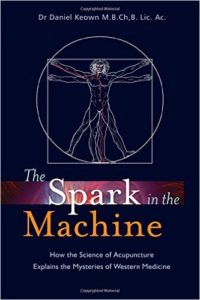 There’s so much going on in this book, The Spark in the Machine, that I feel I need to bite-size it. And it starts with one of the best chapters I’ve ever read in non-fiction. That’s because it is non-fiction, but reads like fiction. The author caught his thumb in a folding chair when he was three years old. Though it was reattached at the hospital, what I didn’t know (and many other medical people also don’t know) is that he would have been able to regenerate that tissue without surgical intervention!
There’s so much going on in this book, The Spark in the Machine, that I feel I need to bite-size it. And it starts with one of the best chapters I’ve ever read in non-fiction. That’s because it is non-fiction, but reads like fiction. The author caught his thumb in a folding chair when he was three years old. Though it was reattached at the hospital, what I didn’t know (and many other medical people also don’t know) is that he would have been able to regenerate that tissue without surgical intervention!
Say whaaaaa? Yup. Though it seems like a super power,
amputations above the last joint in children under six left to heal naturally would regrow, the entire finger, without a scar or deformity.”
*Note, please don’t try this out on your neighbour’s kid, no matter how noisy they are!
My own notes on tissue regeneration
I knew that some animals have this ability. Lizards can regrow their tails, spiders can grow a new leg (glad to know that one, as I’ve accidentally amputated a few spiders in my attempts to catch and release them!), sharks replace lost teeth, starfish rebuild new arms, and animals with antlers shed and regrow them annually. Some animals are so good at regenerating that they can replace any part. Flatworms, sea cucumbers, and sponges can be cut into pieces, and each piece can become a new creature. Wouldn’t it be great to be able to duplicate yourself just once so you can be twice as productive?!
Even you can regenerate parts of yourself. We’ve known this for a long time. There’s even an ancient Greek myth about it. Prometheus was a Titan (a race of gods) that got himself into a bit of trouble with Zeus. Zeus was said to have a quick temper, so when Prometheus peeved him badly, Zeus had Prometheus chained to a rock to have his liver devoured every night by an eagle. Every day Prometheus’ liver would regenerate, only to be gnawed on each night. While we don’t have the ability to regrow our liver from nothing, it can regenerate its own tissue and function normally provided as little as a third of the tissue is present. This isn’t an excuse to abuse your poor liver, however!
Scientists have studied how animals are able to undertake this amazing task of regeneration and they’ve discovered that changes in electrical current and reversal of polarity actually causes the blood cells to become primitive stem cells again! Stem cells are unprogrammed cells that can repair and replace any tissue in the body. They can become a liver cell, a muscle cell, a skin cell, whatever the cell is needed. In other words, the valuable kind of cell that we’re researching for its potential to heal all!
One scientist, an orthopedic surgeon R.O. Becker, showed that
higher animals, such as rats, can sometimes regenerate limbs, especially if he provided the injury site with an extra boost of electricity.”
The problem for mammals, however, is that as we get older and as the injury becomes more severe, the weaker our “regenerative powers” become. Becker came to the conclusion that the more complex and bigger the brain of an animal, the more energy it spends on that brain, and the frailer its regenerative abilities.
But since we can repair and replace many of our damaged and old cells, we must have some sort of electrical energy driving that. And Becker found that it’s not the same as nerve impulses. So, what is it? Some call it Qi. In my next section, I’ll cover The Spark in the Machine‘s next chapters that dive into the meaning of Qi.
The Spark in the Machine: How the Science of Acupuncture Explains the Mysteries of Western Medicine
By Dr. Daniel Keown
Dr. Keown is both a medical doctor in the UK and a doctor of Traditional Chinese Medicine. “The book shows how the theories of western and Chinese medicine support each other, and how the integrated theory enlarges our understanding of how bodies work on every level. Full of good stories and surprising details, Dan Keown’s book is essential reading for anyone who has ever wanted to know how the body really works.”
